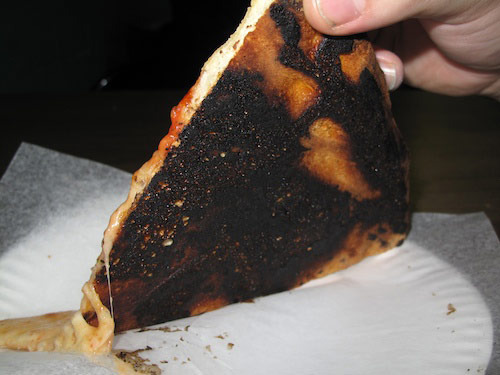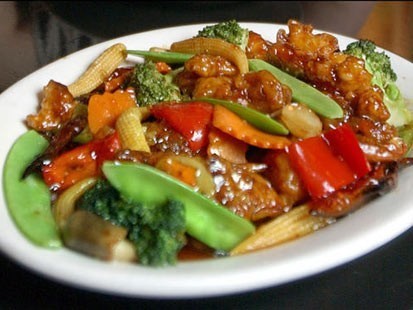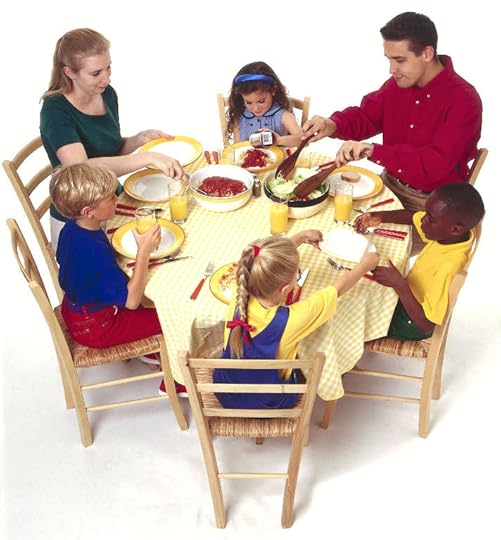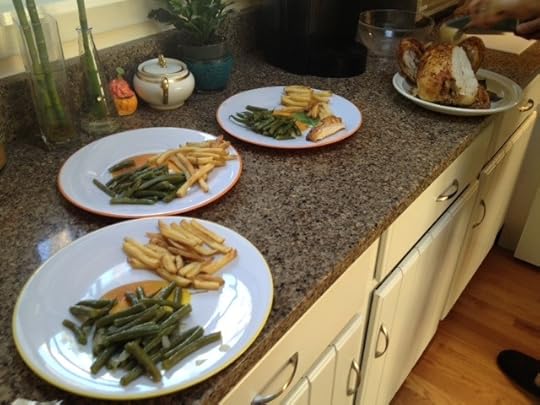Katja Rowell's Blog, page 4
August 22, 2013
Isn’t it ironic? Nutrition rules spoil eating…
“I guess we’ll just have to fill up on S’moreos.”
Scene: summer camp, Kindergarten through 2nd grade
Cookout lunch where kids bring ingredients for grilled tortilla pizza.
What happened as reported by a 7 year-old:
“Brittney, the counselor-in-training, kept trying to make us all eat our celery, there were carrots too. No one liked the celery. It was really stringy, but we had to eat three pieces. We tried to give them all to one kid who liked it, some kids threw them under the table, and then they burned the pizza so we had to eat black tortilla pizzas, and then we got extra S’moreos because we were so hungry.”
Classic.
So many symbolic and real implications, but just wanted to share this quick gem.
Side note, this child eats spinach salad, kohlrabi, beet salad and a variety of veggies. She doesn’t like plain, raw celery among other things. Are children not allowed to have opinions/preferences about food? She also discovered she prefers S’moreos to the classic S’more.
August 21, 2013
Stupid things ‘experts’ say #7: “The way you eat is unacceptable.”
I cringed when a client told me that their new pediatrician admonished her five-year-old son (with severe food anxieties and selective eating who would likely qualify for a feeding disorder diagnosis) with this: “The way you eat is unacceptable.”
I cringe often, when I hear some of the things that my colleagues in medicine say to young children, even if they think it is for their own good. (My guess is that this doc has no experience or education around feeding problems, all too common I’m afraid. See Stupid things #6, and #4 , and #1. )
Young children in particular are unable to process a message like, “The way you eat is unacceptable.” What the child hears is, “You are unacceptable.”
Guilt, shame, lectures, prodding, or tough love don’t help children (or their adults) make better choices. In fact it likely makes the anxiety about eating worse, and we know anxiety is the enemy when learning to eat.
I’m not saying that a child with feeding struggles should be dismissed or ignored, but the parents primarily need help to support their children. Children don’t need lectures, rationalizing, shaming or bullying—from peers or their pediatrician. While the 2 or 3 year-old selective eater doesn’t feel a lot of shame about eating, the five year-old certainly can. The five-year old who so desperately doesn’t want to let down his parents or his new doctor that he will agonizingly swallow two bites of apple-sauce while crying and gagging before refusing altogether…
How about the doc tries:
“I’m sorry you had that experience where you couldn’t find anything to eat at that party. That must feel really tough. Let’s see if your mommy and I can figure out a way to help.”
“You like pancakes? Me too! I like mine with blueberries. Maybe you can help your Daddy make pancakes sometime. It’s super fun!”
Hitting people is unacceptable, swearing at the table or throwing food may be unacceptable, but the way a child eats is the way a child eats right now, for any variety of reasons, with many of the child’s behaviors being understandable reactions and adaptations to painful or coercive experiences. Accepting, unconditional love and support will go further to helping him learn to feel good about food and eating than shame or guilt.
Primary care docs can’t be expected to solve these complex issues in a 7 minute well child check, but they can do a better job of learning about, screening for and supporting parents. Learning about feeding problems, and getting the right help for the family is key.
What is the worst thing someone has said to your child about his or her eating? (Everyone is fair game, from siblings, MILs to doctors or therapists…)
August 7, 2013
Training Adults to Identify Hunger: Do Kids Need “Training?”
Recently, an interesting journal article has been making the rounds about training adults to recognize and respond to hunger cues. Essentially, the researchers asked study participants to pay attention to when they felt hunger: described as “EHS” or empty hollow sensation of the stomach, and “inanition,” or more of the feelings of anxiousness, fatigue, headache etc. that often come later. They then tested blood sugar levels in the subjects and by doing so, were able to help subjects link the objective low blood sugar with hunger, helping to differentiate hunger from other cues. The theory is that many adults can no longer recognize hunger, eating for other reasons (pain, boredom, social cues, nausea) and that this contributes to insulin resistance and weight gain in the subjects and overall population. Subjects in this weight loss study were then instructed to eat when they felt hungry. (Contrary to typical advice for diabetes and weight loss diets to stop when you no longer feel hungry, or when you feel full…)
Here are some of the findings/comments from the authors I found most interesting/useful:
“Eat when you feel hungry” feels very different from “stop when you are full.” “Stop when full” often feels restrictive, confusing and negative, and is part of why so many diets fail.
It can more difficult to sense fullness vs. hunger, and insulin resistance can make it even more difficult to sense initial feelings of satiety.
Eating is recognized as pleasurable, and the participants were not told to eat less, but to eat at the onset of subjective hunger (confirmed with objective measures). This is more likely to lead to compliance since it does not deny pleasure, nor does it feel restrictive.
Rating hunger on a scale seems less useful and more difficult for folks than merely recognizing its presence, and that may be enough. EHS comes before inanition, and subjects were not asked to wait until inanition, but to eat at any indication of hunger (readiness to digest).
Subjects did not report change in activity or energy level.
Trained subjects learned relatively quickly to correlate internal sensations with blood glucose measures.
Blood glucose and insulin sensitivity improved in the trained group, they also lost weight overall (so did the standard diet group, but by the end of the seven weeks, the diet group intake was increasing, suggesting “disinhibition,” or falling off the proverbial diet wagon.
Some of the “normal weight” folks lost weight, though most did not. There were no goal weights, though it was a “weight loss study…”
IH meal pattern emerges: “subjects were able to arrange their meal size and composition to ensure that IH appeared just prior to the following meal-time with a mean error of half an hour in 80% of adults and 90% of children*”-(though I can’t find the reference for this statement or an indication as tho which children this refers to…) Lends support to offering regular opportunities for meals and snacks with some flexibility.
Questions I have:
One concern is that the control group followed typical dieting practices, so we are comparing the intervention to a control group that is partaking in what we already know to be harmful and counterproductive. How would the study have differed if the control groups had been given different instructions, or none at all?
Study only went on for 7 weeks, what might this look like 6 months or a year out, when they weren’t participating in a weight loss study?
This was a weight loss study, which may color the motivations and maintenance outcomes.
Did the study participants ability to tune in to hunger cues and eat accordingly continue, or was the process somehow cumbersome or hard to maintain?
I would have liked to see a breakdown of weight and blood glucose/insulin by participant. Did some of the “overweight” subjects maintain weight, but still see blood sugar and insulin improve? Just as some “normal weight” improved with blood measures while weight stayed stable? Would be curious to see more.
Average BMI before the study was about 28-29. Does this differ at various BMI ranges, and depending on personal history as in life-long dieting, or history of or active eating disorder? Would have liked to know more about study participants and those who dropped out.
Would love to know more about the timing of meals that resulted. One area said that study participants delayed meals waiting for hunger signals from “2-48 hours…” Explain please.
Seemed like authors approached things differently, with one author advising “light meals” in response to inanition, so perhaps there was some restriction? This concerned me in terms of whether the researchers were following similar protocols, and if there was indeed restriction or asking them to eat based on external, vs. internal cues. Not clear.
I was most struck with their strong recommendation to teach children hunger signals, “Training in Hunger Recognition should begin in infancy and continue through childhood.” Though they admit that there is controversy between those who believe hunger is instinctive and doesn’t need to be taught, but supported (as I and others do, I don’t want to speak for others but it seems consistent with Ellyn Satter’s eating competence model and Tribole and Resch’s Intuitive Eating) vs. hunger cues must be taught. I think this is a critical distinction. The authors mention several common tactics that bury inborn skills, like insisting on a clean plate, but offer no concrete examples or resources on how to “train” children to recognize hunger cues.
Seems clear that these authors come down on the side of teaching kids hunger cues. I don’t mind theorizing about why many children and adults lose touch with hunger cues, but I take issue with their conclusion that children need to be taught hunger cues, and bet that this study will be cited as support for teaching children hunger cues, while the study did not include actual children.
I believe that hunger and satiety are innate, and that with supportive feeding, children learn to rely on and eat according to those cues. I worry that someone doing a casual read of this article, or only reading a headline, might try “training” small children in ways that are ultimately harmful, interfere with the natural process, and are developmentally inappropriate. The last thing I want to see is a bunch of preschoolers being harangued after every bite to check in with a hunger and fullness rating scale…
I do find that this is hopeful as it supports the idea that adults can learn to tune in to cues again. I like to say that we can feed children in ways that support or bury internal cues. (Different than saying destroy or leave adults unable to get back to internally regulated eating.)
What are your reactions to the study, and my musings?
*The article overall was confusing for me as it reviewed several studies, one in infants and diarrhea for example, and mentions “children” in one area with no reference, or connection to the main study. The central study in the piece is training hunger recognition and correlating with blood sugar was done on adults.
August 2, 2013
“When my parents gave up on my eating, that’s when it happened.”
I love my work: that thrill when a client makes a connection, sees things a new way, perhaps understanding how the things s/he was doing to try to make a child’s eating “better” may have actually slowed progress. A dad I talked to recently shared the following, when we discussed how his own history around food can help him relate to his daughter’s picky eating and food worries.
For a little background, this dad was very picky as a child, eating only a handful of foods. He remembers a lot of nagging, rules, and bribing with desserts. He shared that both he and his wife now enjoy a great variety of foods in many different preparations. I asked how and when he thought this changed for him, that is, his willingness to explore. His answer was so clear and inspiring, and explained so many principles well that I asked him if I could share, and he graciously agreed. (Paraphrasing…)
“Well, I can actually pinpoint it to one meal when I was about ten. I remember sitting there, having my plate of whatever it was, I don’t even remember, I just know it was really plain and what I ate all the time. I looked over at the Chinese food my parents were eating. I vividly remember thinking, ‘Wow, that smells and looks so much better than what I’m having.’ So I tried and liked some of it.”
As I probed further about his family meals growing up, and why he thinks he made the shift, he went on to say that he thinks he only got to that point because his parents had “given up on my eating“: the nagging had stopped, and they just ignored what he was or wasn’t eating, though they still sat down to family meals. By the end of that summer, he reports eating about “ten times more foods” than at the start. Often once that barrier is broken, progress can come quickly…
“As we talk about all of this, and how our daughter may be feeling pressured and put off, I can see now that I only tried new stuff after my parents had given up, when there was no pressure.”
Rarely do I hear adults able to pin down one meal (though my facebook discussion on this topic readers pinpoint a sandwich with tomatoes, a study-abroad semester, a casserole…) I thought this account is particularly fun and hopefully reassuring to parents of picky eaters out there. It can take time, often more than you like, but even picky eaters can and do learn to branch out. Here are a few things the story illustrates that will be familiar to regular readers:
Pressuring kids to eat more or different foods usually backfires.
Internal motivation (I want to try that) is the key, and that is what parents can nurture with supportive feeding.
It can feel hard not to lecture, praise, pressure, and bribe because right now, “good parenting” in the cultural norm most often means pressure and controlled feeding.
Ignoring your kids at the table, (okay, not really) but in terms of what and how much they are eating from what you provide helps to bring down the pressure and anxiety, and allows that internal curiosity to flourish. “Hmm, that looks better than what I’m having!”
It can take a lot of time before you see that internal motivation kick in. Your child may not be three and eating sushi, but she might try it when she’s 13.
What have you seen with your kids? How about your own eating?
July 16, 2013
First Family Meals for Fostering and Adopting Families
A reader asks:
“As we near time to bring home 2 kids on visitor’s visa whom we are adopting who are selective eaters, I’m trying to make sure I have a plan in place with regards to safe foods being offered at each meal. They favor noodles, pizza (which we all can eat), hotdogs, and blini and cheese on bread or separate and yogurt & cucumbers and pickles. Do I just make sure we have noodles or pizza or blini or cheese or hot dogs at each meal in addition to the foods that my other 2 kids and my hub. and I want to serve/eat (like meatballs, veggies, etc).”
First of all, I am so happy that you are thinking about all of this in advance, and that you are focusing on family meals, and keeping the needs of everyone at the table in mind. Family meals can be an amazing opportunity for completing those bonding cycles, by meeting a child’s need over and over. Meals are also repetitive, sensory-based and relationship building (important characteristics of bonding opportunities according to Dr Bruce Perry of the Child Trauma Academy.) While meals are an opportunity to strengthen attachment, as you allude to in your question, the family table can also be a place for confusion and even conflict. Being prepared in advance makes a big difference! Many parents say they felt blind-sided by the challenges at the table!
You seem to have more information than many families have who may be fostering or waiting to bring their children home, which is great and you are thinking about it all in advance. Since you know several favored foods, planning on serving at least one favored food with every meal and snack in the beginning is a great idea. Avoiding pressure and power struggles over food is critical, and will help all your children eat better, and will help you build trust and attachment with your adopted children. I will answer some specifics, and offer some general thoughts as well, and stay tuned for a sample menu at the end…
If noodles are familiar, consider serving them different ways: plain with possible sides like cheese, butter or tomato sauce, or cold with a mild dressing like a pasta salad. Using familiar foods in different ways is a great way to introduce new flavors and variety.
Count on your other children noticing, and maybe also only eating the favored foods for a time. That’s okay too. There is a natural drive for variety, and the pace of progress will differ.
If your children are older, you can ask them about their favored foods. If they come from a particular country, sometimes finding a Russian deli or an Ethiopian grocer, or learning how to make Injera for example, may be a comforting and loving gesture.
Plan on serving meals and snacks at regular and predictable intervals. You may want to offer food more often at first, even every hour or so, if your child is new to you, and possibly comes from a food insecure background. (Read my article on anticipating and healing food insecurity for more.)
It sounds like they are able to eat foods of different textures, like chewy pizza, crunchy pickles etc. If a child is clearly struggling or only eating soft foods, and you are worried about oral-motor skills (delays are more common in adopted and foster children) consider seeing a speech therapist or feeding evaluation, but remember that bad therapy is worse than no therapy. (Here is my list of questions to ask your feeding therapist.)
Feed your child at her skill level. Many children, even with some oral-motor delays, don’t need therapy if they are eating enough variety and are progressing. For example, a three year-old who has had little exposure to variety in flavor or texture may need foods prepared that are more typical for a young toddler. Feeding in a responsive way is critical. If for example, your three year-old seems to struggle with pizza, cut it into small sizes, or pull off the cheese and offer small pieces. Be ready to have foods with different textures and appropriate to varying skill levels. i.e, you might start with serving sloppy joes or slow-cooked pulled chicken, vs. starting with a tougher steak.
If there is a language barrier, learn simple phrases like, “There will always be enough, ” or “You don’t have to eat anything you don’t want to.”
Many children adopted from abroad have nutritional deficiencies. Here is a great resource including what to test for and how often, and nutrition concerns based on country of origin. If your children accept them, offer a chewable or otherwise palatable multivitamin, possibly iron supplement, and a chewable DHA supplement.
Try not to guess what they may or may not like. I remember taking a young family member out to a Lebanese restaurant as a toddler, thinking she would like the warm, soft, bland bread. Instead, she ate almost exclusively the pink pickled veggies.
Serve a variety of foods, including fruits and veggies in many different ways. Take blueberries for example: serve fresh, frozen (straight from the bag), in pancakes (might top with powdered sugar vs. syrup), in muffins…
Consider 100% fruit juice or nectars offered with meals or snacks once a day. You can water down the juice.
Consider making yogurt smoothies or frozen pops.
Have your children help you with an herb or tomato garden (or window container), shopping or cooking in any way that is fun and rewarding. Great way to connect, engage the senses, and become familiar with new foods.
Remember that battling about nutritional goals now is likely to make your child’s long-term eating and nutrition worse. So even if you do worry about high fructose corn syrup or sugar, allowing your child to enjoy foods, and try new foods, even if they are not nutritionally “ideal” will get you closer to the long-term goal of raising a competent eater than strictly trying to control or pressure the “perfect” foods. For example, if your child only eats fruit with a little sugar, IMO it’s best to allow it than to refuse the sugar and have the child refuse to eat the fruit altogether. (Same goes for ketchup and other sauces. Studies show that condiments and flavor increase the variety of accepted foods.)
Sample meals:
breakfast: Scrambled eggs (or other regular family favorite), toast, served with yogurt in bowls and a few topping choices like bananas, blueberries (kids can chose and sprinkle, like a sundae bar, or make parfaits in pretty cups)
snack: cubed cheese, sliced apples (half with skin, half without), crackers, milk or water (can offer yogurt for dipping the apples, or sprinkle with half 1/3 cinnamon, 2/3 sugar on occasion.)
lunch: build your sandwiches: bread, cheese, deli meats, chips on the side, fruit salad
snack: tuna or egg salad, crackers, yogurt smoothie
dinner: spaghetti with various topping choices, raw and cooked broccoli, grapes, pudding for dessert
Keep rotating new foods, things you enjoy eating as a family, serve family-style, or help your children serve themselves if that is what they need.
Remember to always keep your child’s emotional or “heart needs” first and foremost. I see so many parents who worry about nutrition or weight getting into serious battles around food, and it not only harms the feeding relationship, but can slow or even impede attachment as well. If you are worried, get help. Oh, and keep me posted!
For more information, see my book, Love Me, Feed Me: The Adoptive Parent’s Guide to Ending the Worry About Weight. Picky Eating, Power Struggles and More
July 8, 2013
Selective Eating Adults: Permission, Trust, and Patience for You Too!
Aren’t these the most gorgeous eggs?
From a reader on FB:
“Wanted to share something with you…we’ve been trying to be really mindful of feeding our kids. I was really selective as a child and even into adulthood. I wanted to make sure my kids didn’t feel badly about their food choices, whatever they are. At any rate, one hold out for me was eggs. I have this vast set of rules for how I will eat them that makes no sense to anybody else. I decided to treat myself the way I treat my daughter and allowed myself to try without pressure. I found that I actually didn’t mind them and they didn’t taste as I had imagined! A while later, the worst thing happened: they got my order wrong at a restaurant and the eggs came fried and runny instead of scrambled (this was only my second time trying them!). I again allowed myself to try without pressure…and I enjoyed them! For more than 30 years, I’ve been afraid of them! I can’t say that it’s something I immediately think about eating when breakfast is suggested, but it’s nice to let go of some of the burden and some of those “rules.”
One of the most satisfying things is when I work with parents of children with picky eating or selective eating, and parents make their own discoveries and progress, finding their own joy around food. Many adults read my blog or ask for help with their children because they themselves are picky, and want to do the best they can to help their children enjoy a variety of foods. Many clients remember being forced to clean their plates as children, or forced to eat a food (at times even vomiting) that they won’t touch to this day… They know they don’t want to do that with their kids, but don’t always know another way.
I loved working with adults with selective eating, but now work almost exclusively with children. (Working with adults directly was so much fun. Watching them make a discovery during a mindful eating activity, or share their progress with wonder was really fun. Now, I love having parents share the successes their children make, but hearing it from the client directly was really a kick!)
If you are an adult looking for SED resources, I highly recommend the book, Secrets of Feeding a Healthy Family (the first 1/3 is on adults and eating), which some readers have called their “blueprint” for picky eating as adults. If you need personal support, my friend and colleague, Michelle Allison at thefatnutritionist.com is my go-to resource.
Here’s what a recent client of Michelle’s wrote on Twitter: “helped me deal with picky eating and food anxiety. AND turned me into a unicorn. Now I just eat rainbows.”
The same principles apply whether it is to children or adults: pressure almost always backfires, and curiosity, kindness, permission to eat-or not- are the keys. What say you?
Join the discussion on facebook! Seems like all the fun happens there these days 
July 5, 2013
Afternoon in a French Park: Food as Connector

At a park a few weeks ago in France, there were three somewhat disheveled older men drinking (alcohol I presume) and sitting on a park bench. The men stared ahead, saying little between swallows.
Meanwhile, my daughter and several other children were gathered around a green hedge a hundred yards away or so. I wandered over to see what they were doing, and noticed they were eating something. Excitedly, M ran to me with a few (rather unripe) raspberries in her hand. The sign on the neatly kept raspberry bushes read, “These are from nature, help yourselves.” I wandered back to my bench, fascinated that the children were glowing, intent on their edible labors, enjoying each other in spite of the language barrier. M brought a few berries to a little boy with a cast and crutches sitting on a teeter-totter watching other children playing. He smiled at her, and they teetered and tottered for a while.
Pretty soon a well-dressed woman came along, greeted the three men on the bench with kisses on both cheeks, as is the custom, and sat. She pulled three small packages from her rather large leather bag (it matched her shoes), and handed a package to each man. They beamed, opening the packages, chatting, smiling and eating. She didn’t drink with them, but ate as well.
Soon, one of the men got up and shared some crumbs with a a few pigeons nearby. He looked down at them, talking tenderly, grinning ear to ear.
On another bench a couple with several children along pulled out little fruit pouches and cookies, sitting together and signing ‘Happy Birthday’ to one of the boys. They laughed, teased, smiled, ate and sang.
It just struck me how much food connects us, how much feeding is an act of reaching out, of giving and sharing, how intimate it is to share the same foods, flavors and experiences. I was so struck by the easy way the woman fed the three men and sat in companionship, and how one of them then found further joy sharing his food, even if it was just with a few pigeons. What need is this to share food with others? Why does this bring joy to both the giver and the receiver?
What do you think? How have you witnessed or been part of food bringing people together, conversely, how has food, or conflicts over food perhaps, affected a relationship in a negative way?
P.S, I’m back from a rather extended family vacation, happy to be home and ready to hit the ground running with work on Monday! Have a wonderful weekend!
June 4, 2013
Heavy-duty foil saves clean-up time, and green bean recipe!
I finally made green beans a different way than the usual standby of simmering in broth with a little butter and salt. Husband and I used to eat green beans like this often, but they can be stringy, so when I started cooking and considering the oral skills of a little one, I switched to the softer boiled/steamed beans and kind of got stuck— but stuck in a good way since we all loved them anyway.
Roasted garlic/ginger/sesame green beans

Prep time
10 mins
Cook time
20 mins
Total time
30 mins
Quick prep green bean side with Asian flavors. adapted from Cooks Illustrated
Author: Katja Rowell, MD
Cuisine: Asian influence
Serves: 3-6
Ingredients
1 pound green beans, snap off the stem end, keep pointy ends on, wash
1 Tbspn EVOO
sauce for step 2. mix all ingredients in a small bowl:
1 tspn EVOO
¼ teaspoon sesame oil (recipe says ½, but I find it can be overpowering)
1 Tbspn minced garlic
1 teaspoon minced ginger
½ tspn hot red pepper flakes (I used about ¼ since M isn’t a fan of too spicy, and it was her first time with this in a long time.) can omit altogether
2 teaspoons honey
Instructions
preheat oven to 450, line pan with foil, spray with oil or small amount of oil. Rack in middle position.
Spread beans on sheet, drizzle 1 tablespoon of oil and mix with hands, coating beans. Layer evenly and roast for about 10 minutes.
step 2: take beans out of oven, pour sauce on beans, using tongs, coat beans. Continue roasting about 10-12 minutes, until they get brown spots and start to shrivel. Start watching after 8 minutes so they don’t burn.
* you can also just omit step 2 sauce, and roast green beans with sea salt and a little pepper. Also yummy! Take them out after 10 minutes and give them a stir, then pop them back in.
WordPress Recipe Plugin by EasyRecipe
3.2.1230
Try my favorite Garden of Eden herbs and save time!
Get kids involved
Even young children can snap off the stem end of the beans and wash them. As able, kids can measure and mix the sauce and toss with tongs. If you have a more finicky eater, or want to engage older kids, consider a recipe tasting. Make the beans two ways, one tray with salt and pepper only, and the other tray with the Asian coating. See which they prefer and why? Or change the recipe in other way: less or more spice, sesame seeds…
Gear Gushing
Also want to share that I LOVE the heavy-duty foil. Or rather, my husband and chief bottle washer loves it… One sheet is actually big enough to cover the whole pan instead of trying to overlap two of the more flimsy ones that always tore and leaked, so it really is a simple clean-up. It’s hard enough to get dinner on the table some nights, and if the thought of scouring a pan is enough to tip you into ordering take-out, it might be worth considering!
I will be heading out of town for a few weeks, so no blog posts until after July 4th, but please stop by facebook, where I think I will still be able to pass on hopefully fun insights from feeding and food in France and Germany while I visit family!
Oh, and I HATE trying to estimate how many servings my recipes make. Sometimes 3 of us devour 6 plus typical servings, other times we have leftovers. “Servings” and portion sizes are so individual!
May 28, 2013
Can I know what and how much you should eat, better than your body does?
After years of serving family style (serving bowls in the middle of the table, and allowing family members to serve themselves) I recently had to pre plate dinner for my family. I roasted a chicken and made green beans and Alexia brand oven fries. We wanted to eat outside, and it was getting late and I didn’t want to drag everything outside in bowls and pots. Just wanted three plates.
Here’s the thing. It felt weird, and off, and I didn’t like it. How could I know how many fries vs. beans I might want in that moment, much less two other people who were active at varying degrees, or ate more or less earlier in the day. Or my child, maybe getting ready for a growth spurt, or coming down with a cold…
The notion that I would know what and how much their bodies wanted or needed felt totally unnatural.
Some nights, for example, when I make pork chops, I enjoy a small amount, cutting an inch strip off the chop and savoring other things. Other nights, I really feel like, and eat two whole chops if there is enough.
Plus, by the time we got everything plated, the chicken carved etc., the beans and fries were cold. I forgot that serving at the table generally means hotter food, and I really like my food hot!
If serving family style is new to you, I imagine it will feel as weird, and unnatural and out of control to allow yourself and others to eat what they are hungry for from what is on the table. If you’re getting the hang with serving family style, and seeing the rewards in terms of behaviors and variety, know that not too far from now this will feel like your new norm.
Some families I work with who have small kitchens, or small tables, or can’t handle one more dish to wash without a dishwasher figure out how to pre plate and make it work for them. But I am grateful and plan on continuing our family-style meals! Here is an old post on getting started with family-style serving, and addressing barriers.
What do you think? Are you pre-plating? How is that working? Family style?
May 22, 2013
“Eat it, no don’t you dare eat it!” Confusion and pressure undermines eating skills and trust.
I was recently at a children’s museum in another state. We were enjoying lunch, and I smiled and waved at a gorgeous preschooler at the table next to us. The mom and dad were attentive, loving, affectionate, and working really hard to get the two kids to eat (well, the mom was anyway). I have special experience and interest in helping adoptive and fostering parents, and the family was transracial, with white parents and black children. The adoption is relevant in terms of attachment and trust issues, which I will explain later, but the scenario is one I have observed in all kinds of families:
Here’s the scene: Mom counted and reported every bite to Dad, in front of the children. Mom repeatedly put the pizza into the children’s mouths, or up to their mouths, encouraging them to eat more, one more bite, “It’s the cheese, that’s the best part!” The children mostly refused, turning their heads, keeping their mouths shut, or pushing the pizza away. Rarely, the littler one would comply and try to nibble off a bite.
Then Mom changed tactics, trying reverse psychology, “Oh, no! Don’t you dare take a bite of my sandwich, no eating MY sandwich!” Which didn’t work either…
OK, am I supposed to eat it or not?
I observed that the younger boy appeared to have trouble chewing, I’m not a speech pathologist, but have some familiarity with the issues. I saw what looked like an oral-motor delay, where he seemed to have trouble biting, and manipulating the food in his mouth. He chewed mostly with his front teeth, and used his cheeks a lot to move food around. He seemed to have the skills more in line with a young toddler. I wondered if the chewy crust and pizza that he had to bite and tear off was too hard for him to manage? It seemed so. The older boy, who was about five, seemed a little confused by it all, in particular after he was told to eat more, but then not to? (See worry cycle part I on feeding challenges, and why adopted and foster children are more likely to experience feeding challenges.)
These parents were probably worried about intake. They may have been told that their children needed to gain weight, and to try whatever they had to to get them to eat. I talked with one foster mother who was parenting a little girl who had been taken away from her biological mother largely due to neglect and “failure to thrive” (low weight and disinterest in eating essentially). The pressure this foster mom experienced to get her child to gain weight was unimaginable…
Back to our family at the museum. The parents were trying so hard, loving so hard, but falling into common feeding traps. I desperately wanted to reach into my bag and put my card on their table, but I didn’t…
My general thoughts, but particularly for parents and children working on trust and attachment, or if your child is anxious around food:
The harder you work to get food into a child, the more likely he is to eat less and grow less well. (See the Worry Cycle series and responsive feeding literature.)
Try to avoid talking about how much of what children eat at mealtimes, or reporting to other adults. This can feel like pressure. Either children don’t want to disappoint you and they feel badly, or they won’t want to comply. Either way, pressure to eat can turn kids off the food, or teach them to overeat over time.
Send the message that they can be trusted with their eating! You can do this by putting the foods out there, and then being good company and letting them do their jobs with eating (how much).
Avoid trying to trick or use reverse psychology to get your child to eat. It is simply too confusing, and undermines trust.
Be sure that foods are offered in ways that the child can handle in terms of oral motor skills. Consider an evaluation with an experienced speech pathologist to help you know how to support eating. (See my PDF on questions to ask your feeding therapist.) The younger boy in question may or may not need any outside help. If he can manage foods, and is gaining weight and progressing, support in the home may be all he needs. An eval from an experienced ST who knows about attachment, and will help you support your child may also be appropriate (I go into this in detail in chapter 3 and 4 of Love Me, Feed Me.) Remember, bad therapy is worse than no therapy, so trust your instincts if what you are asked to do in therapy is increasing power struggles. (This mom may have been able to pull small pieces of cheese off the pizza, or cut up the crust already softened with sauce for example.)
Meals are such a wonderful opportunity to connect with your children. Above all, it made me sad to watch these parents work so hard, missing out on the nurturing and bonding meals provide, and alas, probably making things worse in terms of intake and growth… Thoughts?












